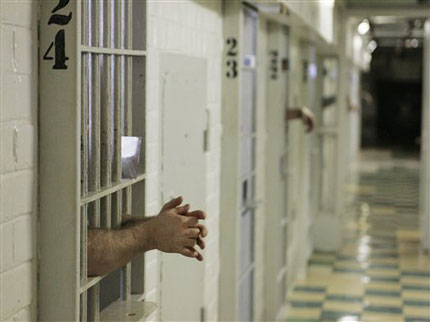
- Oklahoma State Penitentiary cellblock
The first time I went into a prison as a reporter was in the mid- 1970s when I worked at the now closed Tulsa Tribune. The city editor, Windsor Ridenour, assigned me to cover a meeting at the Oklahoma State Penitentiary where the pardon and parole board was convening to decide who would remain behind bars and who would be freed.
I suspect Windsor wanted me to see a rougher side of life from what I had experienced as the son of a minister, but I doubt he had any idea how that visit would ultimately impact my life. I have never forgotten my first trip into the white knuckle hell that is McAlester and that experience is what ultimately caused me to return to prison a decade later and write The Hot House: Life Inside Leavenworth Prison, which recounts a year that I spent off-and-on inside a maximum security penitentiary.
The prison in McAlester is also where I first saw how persons with mental illness were being abused and warehoused. During the mid-1970s, psychotic inmates were shot with Thorazine that turned them into drooling zombies who rarely left their bunks.
I was so disgusted by what I saw inside the prison that I wrote an expose for the Tribune. I thought it would outrage the public and prompt reforms.
But my expose was greeted by silence. There was no community anger, no letters to the editors, not a single reaction from an elected official.
Shortly after my series was published, a cat crawled through a hole into a warm spot seeking shelter. What the cat didn’t realize was that she had taken refuge inside a hollow portion of a state landmark called The Golden Driller.

In 1953, Tulsa commemorated the importance that oil had played in the state and city’s history by erecting a statue of a “roustabout” – a barrel chested oil worker – on the Tulsa fairgrounds. The statue was such a hit that a permanent one built from iron and concrete was put into place in 1966.
Reputed to be the largest free-standing statue in the world, the Golden Driller is 76 feet tall, so high that the figure’s right hand rests atop an actual oil derrick.
A short time after that cat curled up inside the base of the statue, a workman repaired the hole sealing the feline inside. Fortunately, someone walking by the Golden Driller heard the cat meowing and The Tulsa Tribune got a call. I was sent to investigate and I wrote a story about the stranded animal’s plight.
All hell broke loose. Crowds congregated around the statue. A radio station did a play-by-play broadcast when the firemen arrived to free the cat. Syndicated commentator Paul Harvey telephoned for an update.
The cat was rescued.
For a young reporter, the contrast was shocking. I had exposed human suffering in prison and no one had blinked. But the cat had attracted national attention.
I have thought about this may times and I think I understand what happened. The public felt pity for the cat because it was innocent. Those in jails and prisons were not. They were getting what they deserved.
I’m not naive. I know that having a mental illness does not give someone a free pass when it comes to committing crimes and we all know there are criminals out there who are anti-social.
But the persons with mental illnesses I saw in the Oklahoma prison and thirty years later on the ninth floor of the Miami Dade County jail were not hardened criminals. They were men who had severe mental illnesses and had ended up behind bars because of our failed mental health system. Their only real crime was getting sick.
All one has to do to track the “trans-institutionalization” that has taken place in our nation is to compare the exodus of patients from state mental hospitals with the increase of inmates with mental disorders in our jails and prisons. Today there are 350,000 persons with severe mental disorders incarcerated and another 500,000 on probation.
So why is there so little sympathy for persons with mental disorders, who are in jail or are “frequent flyers” — caught in an endless cycle of homelessness and jails?
I believe one of the biggest reasons is fear.
We want to believe that a psychotic man who is in jail or is homeless deserves it because he is a bum, a drunk, a drug addict or simply a bad person. We want to believe that this individual got a mental illness because he was weak minded, had horrible parents, abused drugs, or for some other reason related to his own actions. Whatever he did, he brought it on himself.
We want to believe that because if we don’t – if we admit that these men have an illness that is beyond their control and is something that they got entirely by chance – then, well, that’s frightening because it means we could get it too. It could happen to us or someone we love.
That’s why its easier for us to close our eyes when it comes to the homeless and jailed psychotic men and women around us.
We are afraid.
This is why I believe fear is a huge contributor to stigma. I’d love to learn your thoughts about why my story about the cat in the driller got more sympathy and attention than my expose — so please post a comment.
And if you liked this post, then share it with a friend. Let’s spread the word about the need for mental health reforms.




Although I don't have enough brain power left after hours of homework to comment on the cat vs human idea, I just wanted to comment to say that I find your work incredibly eye-opening and honest. I recently finished reading “Crazy” and I was shocked by the the system you exposed. Your work is inspiring and I appreciate that instead of turning a blind eye, you stare these situations in the face and relay them in an understandable way for those of us unable to see “the inside” the way you do.
I forward your article to everyone I know … whether they want to read it or not is their loss. I agree with you, the public is afraid of mental illness … even in the year 2010! I can ask friends to support anything I do in the art community and receive all sorts of feedback and acknowledgments, yet when I advocate for those suffering with mental health problems or ask for NAMI donations …the lack of interest/apathy is always disappointing! And, as far as the cat in your story, it is much easier to raise money for the Humane Society, than it is for NAMI. I often say, I am forced to treat my son worse than a stray animal on the side of the road, due to a law that protects his civil liberties but does not give me a chance to intervene before it is too late.
People with family members suffering with MI diagnoses still try to hide the truth, due to stigma. Celebrities only talk about the illness after a tragic loss of a love one! Every homeless man or woman, wandering the streets, ranting obscenities … hungry and alone has a Mom, Dad, sister or brother out there that can NOT help due to our worn out, dysfunctional legal system. There really is nothing worse in the world than to have a horrible disease and the disease robs you of insight to help yourself or allow others to help you. And, again the laws have seen to it the only roof over your head may be one in jail or prison!
Thank you Pete for attempting to open people's minds. Keep up the great work! I hope you have the energy to write many sequels to Crazy. I personally have enough documentation to write dozens of books myself but lack the discipline and skills to even think of what it takes to tell the painful story of not being able to help my own son.
Although I don't have enough brain power left after hours of homework to comment on the cat vs human idea, I just wanted to comment to say that I find your work incredibly eye-opening and honest. I recently finished reading “Crazy” and I was shocked by the the system you exposed. Your work is inspiring and I appreciate that instead of turning a blind eye, you stare these situations in the face and relay them in an understandable way for those of us unable to see “the inside” the way you do.
I forward your article to everyone I know … whether they want to read it or not is their loss. I agree with you, the public is afraid of mental illness … even in the year 2010! I can ask friends to support anything I do in the art community and receive all sorts of feedback and acknowledgments, yet when I advocate for those suffering with mental health problems or ask for NAMI donations …the lack of interest/apathy is always disappointing! And, as far as the cat in your story, it is much easier to raise money for the Humane Society, than it is for NAMI. I often say, I am forced to treat my son worse than a stray animal on the side of the road, due to a law that protects his civil liberties but does not give me a chance to intervene before it is too late.
People with family members suffering with MI diagnoses still try to hide the truth, due to stigma. Celebrities only talk about the illness after a tragic loss of a love one! Every homeless man or woman, wandering the streets, ranting obscenities … hungry and alone has a Mom, Dad, sister or brother out there that can NOT help due to our worn out, dysfunctional legal system. There really is nothing worse in the world than to have a horrible disease and the disease robs you of insight to help yourself or allow others to help you. And, again the laws have seen to it the only roof over your head may be one in jail or prison!
Thank you Pete for attempting to open people's minds. Keep up the great work! I hope you have the energy to write many sequels to Crazy. I personally have enough documentation to write dozens of books myself but lack the discipline and skills to even think of what it takes to tell the painful story of not being able to help my own son.